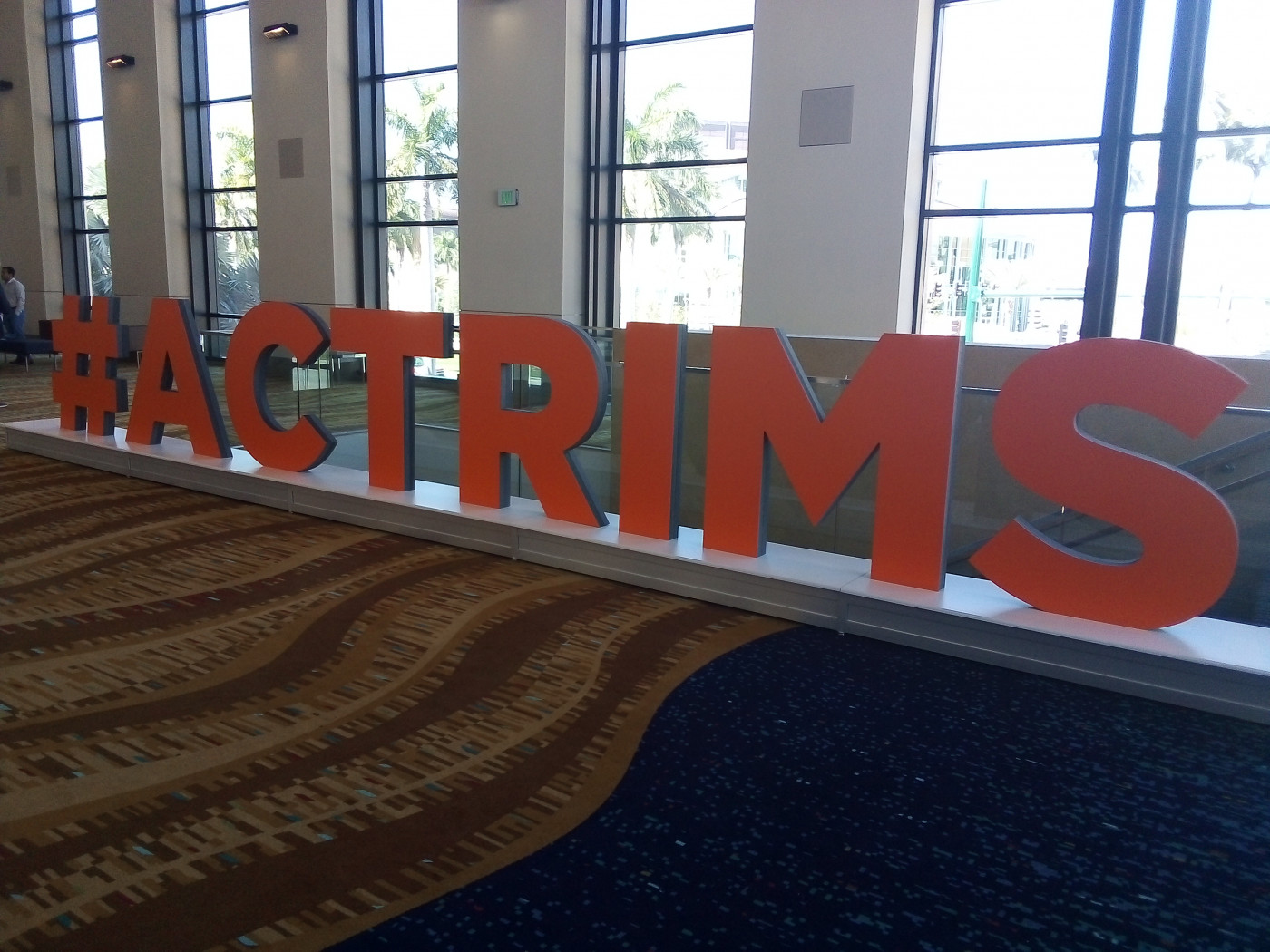#ACTRIMS2020 – CNM-Au8 a Potential ‘Breakthrough’ in MS Therapy, Clene CMO Says
Written by |

#ACTRIMS2020, photo by Jose (Bionews)
An investigational therapy that uses nanocrystals of gold to help the brain repair itself represents a breakthrough in the multiple sclerosis (MS) field, says Clene Nanomedicine‘s chief medical officer Robert Glanzman.
Glanzman, MD, recently presented promising results at the ACTRIMS Forum 2020 indicating that Clene’s lead candidate CNM-Au8 — a biocatalyst aimed at promoting remyelination and neuroprotection — improves the vision and mobility of patients with relapsing MS, which includes relapsing-remitting and secondary progressive disease.
Early findings showed that CNM-Au8 fosters a robust production of new myelin protecting nerve fibers (axons) within the central nervous system (CNS; brain and spinal cord), and by doing so, it restored the motor skills of animal models of demyelination, or myelin loss — a hallmark of MS.
Consisting of a solution of gold nanoparticles with a patented crystal structure, CNM-Au8 is intended to support cellular energy levels, a process Clene calls nanocatalysis.
Current MS therapies mostly tackle the early inflammatory stage of the disease, in which patients develop acute CNS lesions that may or may not lead to symptoms, followed by periods of partial or complete recovery.
But therapies that prevent subsequent chronic inflammation and disease worsening over time without attacks, a stage known as secondary progressive MS (SPMS), remain an unmet medical need.
“We don’t have … drugs that either really prevent this chronic, innate immune-driven inflammation in secondary progressive MS. But more importantly, what we don’t have are therapies that promote remyelination or brain repair, either neuroprotection or remyelination, which is really the Holy Grail right now for MS therapy,” Glanzman said in an interview with Multiple Sclerosis News Today at ACTRIMS.
“We want to promote repair,” he said. CNM-Au8 represents “a breakthrough and exactly what the field is hoping to get, which is a drug that strictly is aimed at helping the brain repair itself, both in terms of protecting the axons that are still alive but may be damaged and in danger of dying, as well as remyelination.”
Myelin — a fatty protein sheath covering and protecting axons — is essential for the fast communication between nerve cells, but it’s also “like a babysitter for the axon,” Glanzman said. It helps nerve cells, or neurons, get rid of their waste products while also providing precursor molecules that neurons use for energy production.
When myelin is lost, the axon slows the conduction of signals and it can’t get rid of waste products, which eventually leads to its death, or neurodegeneration.
Brain cells, including neurons and oligodendrocytes — myelin-producing cells — require a lot of energy, and this is where CNM-Au8 could make a difference, according to Clene.
“CNM-Au8 really is a breakthrough in a couple of ways,” Glanzman said.
How CNM-Au8 works
“We are the very first biocatalyst,” Glanzman said. A biocatalyst is a factor that facilitates reactions by making them occur at a lower cost in terms of energy.
“[W]hat these pure nanocrystals of gold do is they will go into the cell, and they’re able to directly donate and receive electrons from the cellular constituents.” In doing so, CNM-Au8 assists in the production of molecules needed to make adenosine triphosphate (ATP) — the energy currency of cells.

Robert Glanzman, chief medical officer of Clene Nanomedicine (photo by Jose Lopes)
Specifically, CNM-Au8 boosts the production of nicotinamide adenine dinucleotide (NAD), a vital factor for the production of energy that exists in two forms — NADH and NAD+. These two versions are known as a redox couple, because they are the reduced (the “red”) and the oxidized version (the “ox”) of the same factor.
NADH can be converted into NAD+ and, in the process, release electrons used for cellular reactions. The flow of electrons generated in this manner is used by mitochondria to produce energy.
CNM-Au8 provides bioenergetic support to cells by taking part in this electron flow. “Each crystal can receive millions of electrons, and this can be done over and over again,” Glanzman said.
It basically offers “free energy” to cells, which will speed up, or catalyze, their energetic reactions while also helping eliminate toxic byproducts caused by the disease.
The way in which CNM-Au8 nanoparticles are crafted is critical for their ability to do this. The nanocrystals are faceted, which creates points at which electron clouds meet. This is only possible because metals such as gold have a very unique property — their electrons run freely and are shared at the surface of the metal.
“Being clean-surfaced is also critical because if there’s anything on the surface of the crystal itself, it will interfere with this electron transfer,” Glanzman said, adding that Clene was the first to make clean-surfaced nanoscale crystals of transition metals, and that is “really the breakthrough.”
CNM-Au8 is administered as a solution patients can drink. “It’s like an energy shot in the morning. It’s a 60-mL bottle, and you drink it. It tastes exactly like water; it’s 99.9% water, and yet there’s a quadrillion nanocrystals of gold in that one dose,” Glanzman said.
Researchers know that CNM-Au8 builds up in the body over time, and that it reaches equilibrium after about three months.
In all preclinical models tested so far, including animal models of Alzheimer’s disease, Parkinson’s disease, and amyotrophic lateral sclerosis (ALS), Glanzman says they saw “evidence of neuroprotection in rescuing neurons, and not only just rescuing neurons, but we also rescue their neural networks, their ability to talk with other neurons. … That’s really critical.”
VISIONARY-MS and REPAIR-MS
Several clinical trials are underway evaluating CNM-Au8’s potential benefits in neurodegenerative diseases, including two Phase 2 studies in MS — VISIONARY-MS (NCT03536559) and REPAIR-MS (NCT03993171).
VISIONARY-MS is investigating CNM-Au8’s efficacy and safety as a remyelinating and neuroprotective treatment for adults with relapsing MS and chronic vision problems (damage to the optic nerve, or optic neuropathy), a common MS symptom.
Visual impairment in MS is “the most sensitive of all the clinical endpoints that we use to look at clinical damage from MS,” Glanzman said.
“That’s why companies are turning to it more and more now to use as their proof of concept. If you want to repair the central nervous system, you want to be able to show that repair, and you need a sensitive endpoint to show that repair. The visual system is the perfect way to do that,” he added.
Preliminary results of the trial presented at ACTRIMS showed “notable median improvements” in patients’ low-contrast letter acuity (an eye exam using a chart with low contrast between its letters and background) as well as in standard MS functional/clinical scores of gait (assessed by the Timed 25-Foot Walk test), arm and hand function (measured by the 9-Hole Peg Test), and cognitive function (measured by the Symbol Digit Modalities Test).
“I think it’s becoming increasingly accepted that if you can protect the visual system, you’re also protecting the brain and spinal cord. In fact, our data strongly suggest that, because we see effects not only in vision, we’re seeing effects in walking and gait … and in cognition,” Glanzman said.
“[W]hen we see median improvements of two or three seconds in the 25-foot timed walk, that is a clinically relevant improvement. That means people are walking better.” Seeing these improvements “makes us hopeful that, yes, indeed, we can make a really beneficial impact on patients’ lives,” he added.
Glanzman cautioned, however, that these are still very preliminary results, and that the data hasn’t been unblinded yet, which means researchers still don’t know which results are from patients and which are from controls (placebo group).
“We’ve only enrolled about a fifth of the patients so far. But the early data look very, very promising, and we’re very excited about it,” Glanzman said.
He also expressed confidence that CNM-Au8 is safe. “We fully believe that CNM-Au8 is going to be very safe to be administered chronically,” he said.
Even though the data in humans are still too limited, toxicology studies in canines, mini pigs, and rodent models support the assertion that the treatment is safe to use, most notably in that it was not possible to find a maximum tolerated dose — the highest dose of a treatment that does not cause unacceptable side effects — in animal models.
Moreover, gold crystals are essentially inert; they do not bind or interact with any processes or receptors. And they are generally excreted through the liver and feces, Glanzman said. This also raises the possibility of giving CNM-Au8 on top of standard therapies.
In fact, in VISIONARY-MS, patients are receiving CNM-Au8 in combination with available therapies. VISIONARY-MS is currently enrolling patients at sites across Australia, with eight additional sites in North America expected to open soon. Contact and site information is available here.
“We hope to complete enrollment by the end of the year, and if we do, then we’ll have the primary endpoint data by mid-2021. That’s our hope,” said Glanzman, adding that data collected in this trial could back a future new drug application for CNM-Au8.
Another ongoing trial, REPAIR-MS, will measure CNM-Au8’s effects in the CNS — referred to as pharmacodynamics — as well as its movement in and out of the body — known as pharmacokinetics — and its safety in relapsing patients (which includes those with relapsing-remitting and secondary progressive disease) who are on stable treatment with Tysabri (natalizumab).
The study’s goal is to “prove that CNM-Au8 does indeed get to the brain of humans with disease, and does what we say it does in terms of providing bioenergetic support to the brain,” Glanzman said.
REPAIR-MS’ primary measure will be the ratio of NAD+ and NADH as an indicator of how much energy cells are producing. It will be measured using 31-phosphorous magnetic resonance spectroscopy (31P-MRS), a non-invasive imaging technique used to study biochemical and metabolic changes in the brain.
By targeting phosphorus in cells, the technique “allows us to explore bioenergetic markers,” as well as markers of membrane integrity. In addition to NAD, researchers will look at several other bioenergetic markers.
The study is currently recruiting an estimated 24 adults at the University of Texas Southwestern. More information is available here.
“As a clinician who’s treated many MS patients, I can tell you that the Holy Grail is to stop inflammation and promote repair, to make people better. So that is what we aim for, and that’s our hope,” Glanzman said.
“We at Clene are very, very excited about CNM-Au8, and about the potential for this brand-new therapeutic paradigm of using clean-surfaced nanocrystals of transition metals as therapeutic tools. We’re just at the beginning of this journey.”





